 A LEVEL COMPUTING
A LEVEL COMPUTING Database Design
Database Design
 Theory
Theory
7. Data Description Language
Sometimes called the 'Data Definition Laguage' or DDL. The DDL is part of a Database Management System.
The DDL provides the database designer with a way of describing the architecture of the database itself. This is called the 'schema' of the database.
The DDL allows tables to be created that describes
- the structure of each data table
- define primary and secondary keys
- the fields / attributes used within those tables
- the data types and length of each field
- the security / access details of each user
- any validation rules
The technical term for this 'data-about-data' is 'metadata'.
A typical DDL statement is shown below - this happens to be the commands to set up a table in Oracle, which is a powerful enterprise-class DBMS.
CREATE TABLE EMPLOYEE (
EMP_ID NUMBER(8),
LNAME VARCHAR2(30),
FNAME VARCHAR2(15),
HIRE_DT DATE,
SALARY NUMBER(8,2) )
PCTFREE 20
PCTUSED 50
STORAGE (
INITIAL 200K NEXT 200K
PCTINCREASE 0 MAXEXTENTS 50 )
TABLESPACE ts01
LOGGING ;
Some database management systems provide an user-friendly graphical interface to the underlying DDL such as the one below.

When the designer needs to limit what a certain group of users can see \ do whilst logged on, he will create a 'sub-schema' just for that group.
The sub-schema determines which tables that particular group can view or change. For example a group called 'receptionists' could be included that limits receptionist staff to only see Location and Telephone number details of each employee and nothing else. Whereas the 'HR group' can see employment details and so on.
Challenge see if you can find out one extra fact on this topic that we haven't already told you
Click on this link: Data Description Language
Copyright © www.teach-ict.com

